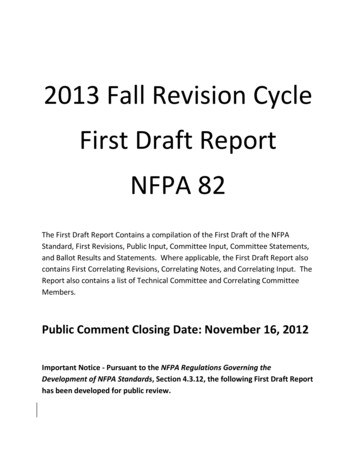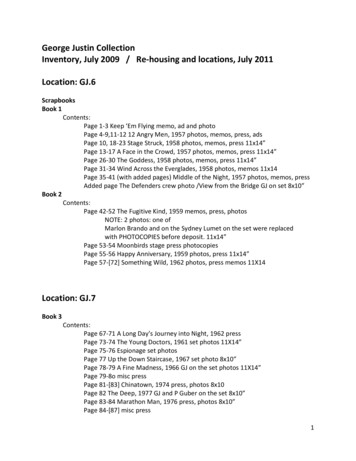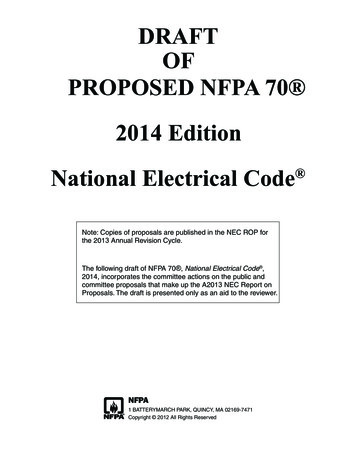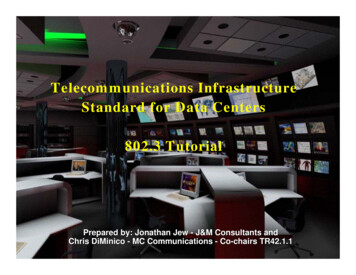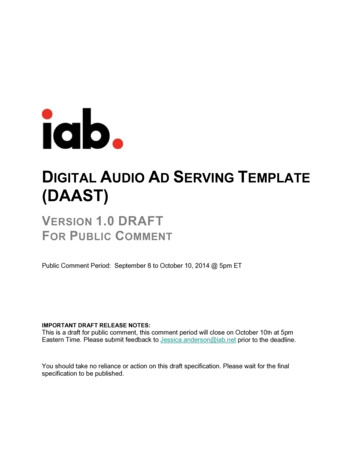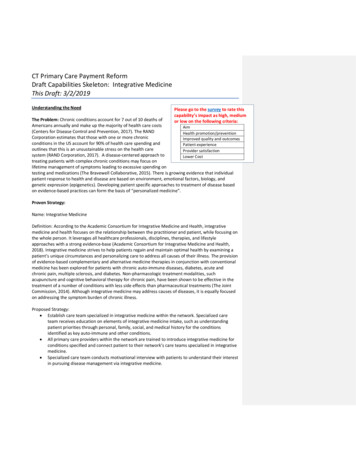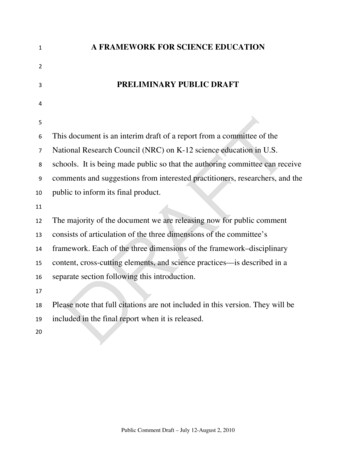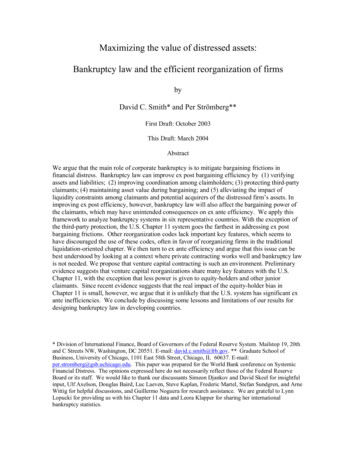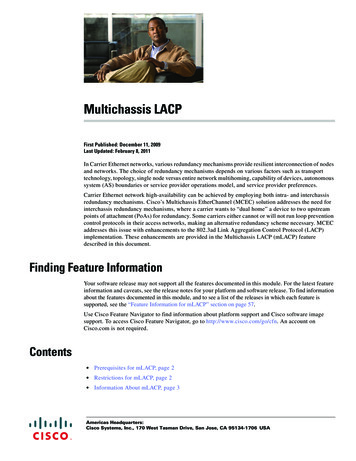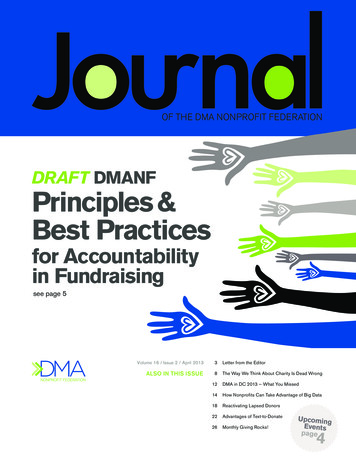
Transcription
OF THE DMA NONPROFIT FEDERATIONDRAFT DMANFPrinciples &Best Practicesfor Accountabilityin Fundraisingsee page 5Volume 16 / Issue 2 / April 20133Letter from the EditorALSO IN THIS ISSUE8The Way We Think About Charity Is Dead Wrong12DMA in DC 2013 — What You Missed14How Nonprofits Can Take Advantage of Big Data18Reactivating Lapsed Donors22Advantages of Text-to-Donate26Monthly Giving Rocks!UpcomingEventspage4
2013 LeadershipDMA Nonprofit FederationAdvisory CouncilChairVice ChairMr. Brian CowartMr. Tom HarrisonDisabled American VeteransRuss Reid CompanyMembersMr. Angel AlomaMs. Karin KirchoffFood For The Poor, Inc.MINDset directMr. Glen A. BeasleyMs. Erika Fry KloehnArbor Day FoundationSave the ChildrenFederation, Inc.Ms. Jennifer BielatEaster SealsMs. Mary BoguckiAmergentMr. Lane BrooksFood & Water WatchMr. Ken DawsonEleventy Marketing GroupMr. Nate DrushellInfoCision Management Corp.Mr. Steve FroehlichALSAC — St. JudeMs. Karen GleasonNNE MarketingMs. Jacqui GrosethUnion Rescue MissionMs. Kimberly HaywoodMarch of DimesMs. Gretchen LittlefieldInfogroupThe world’s largest trade association dedicated toadvancing & protecting responsible data-driven marketing.1615 L Street NW, Suite 1100Washington, DC 20036Phone: 202.861.2427Fax: 202.628.4383nonprofitfederation.orgThe Journal is published online three timesper year — January, April, and September.Alicia OsgoodManaging EditorAOsgood@the-dma.orgLeslie OakeyPublication Designleslieoakey.comMr. Dennis McCarthyBlackbaudMs. Shannon McCrackenSpecial Olympics InternationalMs. Kyla ShawyerOperation SmileMs. Joan H. Smyth DenglerCovenant HouseNews ThursdaysMr. Atul TandonA bi-weekly round-up of nonprofit-specificnews & information direct to your inbox.Tandon Partners LLCMs. Kim WalkerMemorial Sloan-KetteringCancer CenterMs. Kathy WardAmerican Institute forCancer ResearchMr. Roger HiyamaNonprofit CareersThe latest jobs, delivered to your inbox weekly.CDR Fundraising GroupGet connected!Sign up for either newsletter (or both!) by emailing:AOsgood@the-dma.orgStaffXenia “Senny” Boone, Esq.General CounselAlicia OsgoodDirector of Membership & CommunicationsMalene Ward, CMP & CEMDirector of Education & ConferencesDMA Nonprofit Federation@DMANF & @AliOzDCMembers Only
Letter from the EditorDear Readers:The DMA & DMA Nonprofit Federation have a greatroster of events coming up Check out the list on page 4.DMAActiondmaaction.orgMembershippricing & benefits:nonprofitfederation.org/membershipDMA & DMANF continue to lead the way in efforts to protect the nonprofit postal rate &charitable deduction as well as prevent an FTC expansion that would include oversight ofnonprofits. Our success on all fronts to date is due to an overwhelming response from thenonprofit dual membership of the DMA & DMANF on & off the DMAAction site. Thankyou & please keep it up by answering our calls for action via our email member alerts!Remember that if you received this Journal by way of forward from someone outside yournonprofit or company, that your organization or company must have a membership (nonprofit organizations) or Corporate Partnership (for-profit agencies & suppliers) to receiveDMA Nonprofit Federation member benefits. Visit the membership section of our websiteto view pricing & benefits information.In this edition of the Journal: The DMANF Ethics Committee offers the DRAFT DMANF Principles &Best Practices for Accountability in Fundraising for your review & comment toAOsgood@the-dma.org; Dan Pallotta debunks the pervasive and wrongheaded notions about charity; A brief review of the nonprofit sessions at DMA in DC 2013; John Murphy with the big benefits of big data; Richard Becker with tools for reactivating lapsed donors; Jenifer Snyder, Esquire with the rewards of Text-to-Donate; and Erica Waasdorp with an excerpt from her recently published book,Monthly Giving. The Sleeping Giant.I hope you enjoy this edition of the Journal & thank you for your continued support of theDMA Nonprofit Federation.Warm regards,Managing EditorAOsgood@the-dma.orgVolume 16 / Issue 2 / April 20133
Upcoming Eventsfrom the DMA and theDMA Nonprofit FederationOnline Attribution & Digital ChannelTactics y 1, 2013 / 2-3 pm ETMay 22, 2013Direct Marketing 101http://nonprofitfederation.org/node/218Easter Seals Headquarters233 South Wacker Drive, Suite 2400Chicago, IL 60606June 10-13, 2013Integrated Marketing Weekhttp://www.imweek.org/Metropolitan PavilionNew York, NYJuly 16, 2013Offered in conjunction with the 2013 New York Nonprofit ConferenceNonprofit mobile-day-july-16-nyc/DMA Headquarters1120 Avenue of the AmericasNew York, NY 10036Nonprofit Mobile Day is co-sponsored by Napean’s Mobile Commerce Daily.July 17-18, 20132013 New York Nonprofit Conferencehttp://ny.dmanf.org/Grand Hyatt New YorkNew York, NYDMA 2013 — The Global Event forData-Driven MarketersOctober 12-17, 2013http://dma13.org/4McCormick Place WestChicago, ILThe Journal of the DMA Nonprofit Federation
For Your Review & Commentto AOsgood@the-dma.orgDMANF Ethics CommitteeDRAFT DMANFPrinciples &Best Practicesfor Accountabilityin FundraisingWhile a nonprofit does not, by definition, have shareholders, it is similarly accountable to both its donors and theconstituencies it serves through its mission. The nonprofit has an obligation to make solid business decisions to helpit meet both short- and long-term objectives that will, in turn, make the world a better place. The DMANF supports theincredible impact made by nonprofits every year and encourages its members to hold themselves and the industry to thehighest standards of ethical accountability.Donors expect nonprofits to be operating at a high level of standards and transparency. While a given practice or actionmay not be unethical, it may not meet the standards of these principles and best practices. Most importantly, the degreeto which a situation is ethical or not ethical is NOT determined by financial results.General Principlesa. Nonprofits must have a well-defined missionstatement describing what they do and why. Cleararticulation of mission helps donors determinewhether this is a cause and organization that theywill choose to support.b. Nonprofits must act in a way that furthers theirmission. This includes responsible use of resourcesconsistent with their stated mission objectives.c. Messaging to donors must be accurate and transparent. A nonprofit organization must accuratelydescribe how it spends its money, and must do whatit promises to do.d. Nonprofits must apply good faith effort to complywith relevant federal and state laws and regulations.Use of Funds / Cost of FundraisingFundraising to the general public is a key function ofnonprofits because in most cases this is the primary sourceof unrestricted financial support. Without donors, andwithout fundraising activities to acquire and retain thesedonors, nonprofits could not remain active and theirmission delivery would no longer be viable. Fundraising isboth a short- and long-term investment in the mission ofthe organization.a. Management and fundraising costs are a normalpart of doing business.b. Donors give unrestricted financial support. Fundswill be used to best meet the needs of an organization, including investment in fundraising strategiesthat may pay off in later years. Efficiency measuresof a fundraising program, then, can only be basedmore 6Volume 16 / Issue 2 / April 20135
on the organization’s overall program and not ona discrete campaign’s cost ratio. Analysis shouldbe conducted over a financial reporting period orlonger; reporting metrics may include, as examples,the cost to raise a dollar, cost to acquire a donor,long-term donor value, and net revenue available forthe organization to spend on mission delivery.c. Most stable organizations have diversified sources offunding, each with its own cost of fundraising ratio.Taken in total, in accordance with generally acceptedstandards, a nonprofit should spend a majority ofits annual revenue on program. Year over year fluctuations may occur. Should fundraising expensesexceed program expenses in a financial reportingperiod, an organization should offer explanation.Circumstances could include a start-up period fora new nonprofit, or a period of intense new donoracquisition to meet long-term sustainability goalsor to rebuild after a prior period of cost-cutting anddonor attrition. Again, as explained above, a nonprofit’s effectiveness is best measured over time andon a combination of mission, impact, financial stability, and growth.d. In order to provide the most accurate understanding of how contributions are used, circumstancesmay compel a nonprofit to allocate joint costs thatinclude fundraising and/or to perform valuation ofgifts in kind. These are legitimate and commonplaceaspects of financial reporting, are subject to auditand GAAP accounting standards, and are reportedon a nonprofit’s IRS 990.i.6education expense (a “program” expense), whilethe cost of materials asking for financial supportis considered fundraising expense. GenerallyAccepted Accounting Principles (GAAP) Statement of Position 98-2 provides guidance on howto accurately allocate the cost of the multi-purpose activity across expense categories.ii. Gifts In Kind (also known as Value In Kind)valuation is an accounting of goods donated toan organization. For example, a food bank collects both financial contributions as well asnonperishable food donations. Accounting of thefinancial support alone under-reports the trueextent of the food bank’s delivery on its missionof feeding the hungry. Accounting of the goodsdonations helps donors understand the fullpicture of the food bank’s services, i.e., amountof food distributed to local families.As with any financial accounting, it is expected thatan organization honestly and accurately calculatesand reports both joint cost allocations and giftin kind valuations consistent withfinancial auditing standardsand requirements.Joint cost allocation divides the cost of an activity when more than one purpose is served andthe activity includes a fundraising appeal. ACEO’s salary may be divided among program,management & general, and fundraisingfunctions. It is the same with a joint cost thatincludes fundraising costs. For example, anorganization devoted to cancer preventioncould send a mass mailing that includes both abrochure detailing lifestyle changes to reducerisk of cancer, and a letter and pledge formasking for financial support. The cost of theinformational materials is considered a publicThe Journal of the DMA Nonprofit Federation
Partnerships and Agreementswith Commercial PartnersAs a rule, nonprofit staff are primarily focused on delivering on the mission. Contracting with external agencies,consultants, and suppliers is often the most cost-effective means of accessing fundraising expertise. Writtenagreements need to be in place, and at minimum theseshould include documentation about payments due, whatthe nonprofit is getting, and ownership rights of donorinformation and materials produced for a fundraisingcampaign. DMANF makes the following recommendations for agreements made between a nonprofit and acommercial partner:a. The nonprofit organization must always — bothby terms of the agreement and in practice — be incontrol of the program, message delivery, and thecollection of funds.b. The nonprofit must always be in control of and haveimmediate access to all donor names and contactinformation generated from efforts on their behalf.There should be clear understanding of whether andhow the commercial entity will use the donor namesgenerated from campaigns.c. A nonprofit should avoid all actual and perceivedconflict of interest between nonprofit/client andpartner/vendor. This includes organizational conflicts of interest, as well as those that may exist forany staff or Board member. For example, a principlewithin the vendor company should not also serve onthe nonprofit organization’s Board of Directors.d. A contract needs to include a clearly defined,reasonable payment schedule for services and materials to avoid real or perceived conflict of interestwherein proceeds are tied to payment terms, andthe beneficiary of such proceeds (donations) isnot in fact the nonprofit as the fundraising appealstates, but the vendor.e. It is incumbent upon the nonprofit to understandcontract terms, including payment requirements,and confirm that they will not hinder the nonprofit’sability to execute and further advance the mission ofthe organization.f.A commercial entity partnering with a nonprofitorganization should not knowingly or carelesslyhurt or endanger the financial health and/or thegood work or good reputation of the organization.For example, a savvy vendor should not take advantage of inexperienced staff at a nonprofit to enterinto what would be an ill-advised agreement if adequate legal and fundraising marketplace advice werebrought to bear.g. The commercial partner should meet all federal andstate requirements for working with nonprofits onfundraising, and all the various filings should becomplete and up-to-date. JDMANFPlease email your comments on thesedraft principles & best practices toAOsgood@the-dma.org by May 30, 2013.The DMANF encourages itsmembers to hold themselves tothe highest ethical standards.Volume 16 / Issue 2 / April 20137
I want to talk about social innovation and social entrepreneurship. I happen to have triplets. They’re little. They’re five yearsold. Sometimes I tell people I have triplets. They say, “Really? Howmany?” Now, I also happen to be gay. Being gay and fathering triplets is by far the most socially innovative, socially entrepreneurialthing I have ever done.The real social innovation I want to talk about involves charity.I want to talk about how the things we’ve been taught to thinkabout giving and about charity and about the nonprofit sector areactually undermining the causes we love and our profound yearning to change the world.The Way We ThinkAbout Charity IsDead WrongThis talk originally delivered at TED 2013on March 1, 2013 in Long Beach, California.But before I do that, I want to ask if we even believe that the nonprofit sector has any serious role to play in changing the world. A lotof people say now that business will lift up the developing economies, and social business will take care of the rest. And I do believethat business will move the great mass of humanity forward. Butit always leaves behind that 10 percent or more that is most disadvantaged or unlucky. And social business needs markets, andthere are some issues for which you just can’t develop the kind ofmoney measures that you need for a market. I sit on the board ofa center for the developmentally disabled, and these people wantlaughter and compassion and they want love. How do you monetize that? And that’s where the nonprofit sector and philanthropycome in. Philanthropy is the market for love. It is the market forall those people for whom there is no other market coming. And soif we really want, like Buckminster Fuller said, a world that worksfor everyone, with no one and nothing left out, then the nonprofitsector has to be a serious part of the conversation.But it doesn’t seem to be working. Why have our breast cancercharities not come close to finding a cure for breast cancer, or ourhomeless charities not come close to ending homelessness in anymajor city? Why has poverty remained stuck at 12 percent of theU.S. population for 40 years?And the answer is, these social problems are massive in scale,our organizations are tiny up against them, and we have a beliefsystem that keeps them tiny. We have two rulebooks. We have onefor the nonprofit sector and one for the rest of the economic world.It’s an apartheid, and it discriminates against the [nonprofit]sector in five different areas, the first being compensation.So in the for-profit sector, the more value you produce, themore money you can make. But we don’t like nonprofits to use8The Journal of the DMA Nonprofit Federation
Dan Pallottamoney to incentivize people to produce more in social service. Wehave a visceral reaction to the idea that anyone would make verymuch money helping other people. Interesting that we don’t havea visceral reaction to the notion that people would make a lot ofmoney not helping other people. You know, you want to make 50million dollars selling violent video games to kids, go for it. We’llput you on the cover of Wired magazine. But you want to make halfa million dollars trying to cure kids of malaria, and you’re considered a parasite yourself.And we think of this as our system of ethics, but what we don’trealize is that this system has a powerful side effect, which is, itgives a really stark, mutually exclusive choice between doing verywell for yourself and your family or doing good for the world tothe brightest minds coming out of our best universities, andsends tens of thousands of people who could make a huge difference in the nonprofit sector marching every year directly into thefor-profit sector because they’re not willing to make that kind oflifelong economic sacrifice. Businessweek did a survey, looked atthe compensation packages for MBAs 10 years of business school,and the median compensation for a Stanford MBA, with bonus, atthe age of 38, was 400,000 dollars. Meanwhile, for the same year,the average salary for the CEO of a 5 million-plus medical charityin the U.S. was 232,000 dollars, and for a hunger charity, 84,000dollars. Now, there’s no way you’re going to get a lot of people with 400,000 talent to make a 316,000 sacrifice every year to becomethe CEO of a hunger charity.Some people say, “Well, that’s just because those MBA typesare greedy.” Not necessarily. They might be smart. It’s cheaper forthat person to donate 100,000 dollars every year to the hungercharity, save 50,000 dollars on their taxes, so still be roughly 270,000 dollars a year ahead of the game, now be called a philanthropist because they donated 100,000 dollars to charity,probably sit on the board of the hunger charity, indeed, probably supervise the poor SOB who decided to become the CEO of thehunger charity, and have a lifetime of this kind of power and influence and popular praise still ahead of them.The second area of discrimination is advertising and marketing. So we tell the for-profit sector, “Spend, spend, spend onadvertising until the last dollar no longer produces a penny ofvalue.” But we don’t like to see our donations spent on advertisingin charity. Our attitude is, “Well, look, if you can get the advertising donated, you know, at four o’clock in the morning, I’m okaywith that. But I don’t want my donations spent on advertising. Iwant it go to the needy.” As if the money invested in advertisingcould not bring in dramatically greater sums of money to servethe needy.In the 1990s, my company created the long distance AIDSRidebicycle journeys and the 60-mile-long breast cancer three-daywalks, and over the course of nine years, we had 182,000 ordinaryheroes participate, and they raised a total of 581 million dollars.They raised more money more quickly for these causes than anyevents in history, all based on the idea that people are weary ofbeing asked to do the least they can possibly do. People are yearning to measure the full distance of their potential on behalf of thecauses that they care about deeply. But they have to be asked. Wegot that many people to participate by buying full-page ads in TheNew York Times, in The Boston Globe, in primetime radio and TVadvertising. Do you know how many people we would have gottenif we put up flyers in the laundromat?Charitable giving has remained stuck, in the U.S., at twopercent of GDP ever since we started measuring it in the 1970s.That’s an important fact, because it tells us that in 40 years, thenonprofit sector has not been able to wrestle any mar
Apr 07, 2014 · CEO’s salary may be divided among program, management & general, and fundraising functions. It is the same with a joint cost that includes fundraising costs. For example, an organization devoted to cancer prevention could send a mass mailing that inclu
